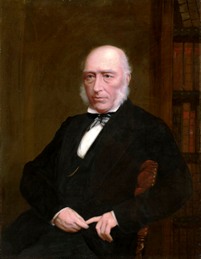
Geoscientist 18.10 October 2008
In August 1835, the geologist John Phillips, keeper of the Yorkshire Philosophical Society Museum, freelance lecturer and assistant general secretary in the British Association for the Advancement of Science (BA), travelled to Dublin to prepare the ground for the annual BA meeting. This was his first visit to Ireland – and his first experience of travelling by train. In a letter to his sister Anne, dated 25 July 1835, he describes the hair-raising experience (all the French errors are
sic!):
"Mais hélas! ou suis-je? - Est ce que Monsieur va par le chemin de fer a Liverpool? a Warrington? a Wigan? Tenez Monsier, permettez moi d'arranger votre baggage. Ah! oui je vois tres bien, que ce grand portemanteau a joli soi de nuit, et ce -- de'alle comment s'apelle cette petite boite? -- So like a lump of sugar I was tossed in & my baggage upon the Railway Auxilium Omnibus (What Latin?) & away we drove. -- Entered the Train & the Railway & fly Jack & be gone. In 80 minutes we reached Liverpool 32 miles, & soon by another Omnibus were landed at our several hotels. My dear Annie You must certainly come to feel the strange impression of this flying Stead of Iron [
sic]. It does so hurry & flurry on, you shake & sleep & start & wonder at the gliding Houses[,] trees & Churches, -- the trains which meet & pass you like the swiftest birds with a rushing sound & the Master power (Steam) & a confused picture of colours & forms not at all distinct as Men[,] Women, Carriages &c that it is all like magic & can not be understood by a mere description. Then you are dragged through a tunnel full of gas lamps, then laid hold of by ruffian porters & crammed into an Omnibus whether you will or no & whirled away the man who guides (only) knows whither.
Me Voilâ."
And you thought commuting into London was difficult!
The letter quoted is one of a series of 234 from John Phillips to Anne Phillips preserved in the archives of the Hope Library at the Oxford University Museum of Natural History (OUMNH) (www.oum.ox.ac.uk). I am grateful to the Acting Director of the OUMNH for permission to quote from the letter, and to librarian Stella Brecknell for all her help with this project].
- If the past is the key to your present interests, visit the History of Geology Group (HOGG) website at: www.geolsoc.org.uk/hogg.
*Nina Morgan is a freelance science writer based near Oxford, UK